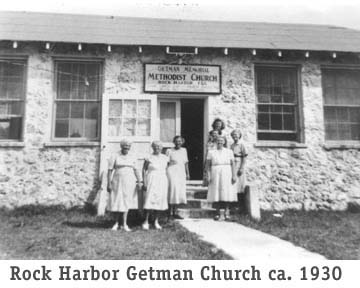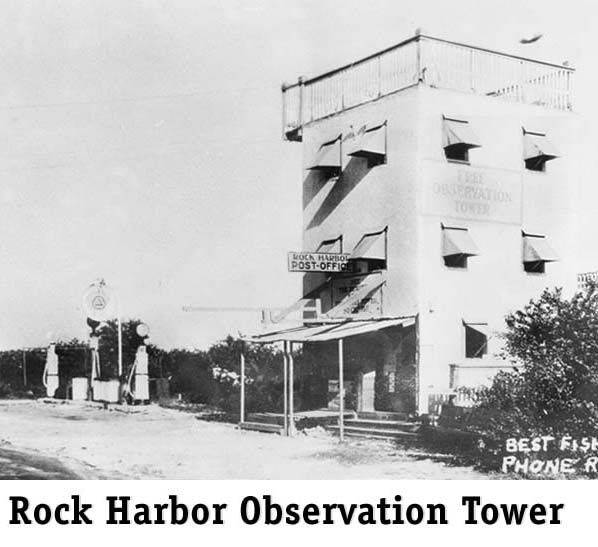|
Even the name Rock Harbor is a mystery in itself as there was no
deep-water
harbor to justify this name for the community. The first substantiated
use of the name began in 1909 as a railroad depot. In the railroad days
the community of Rock Harbor spanned about five miles, using the
present
mile markers from MM 96 to 100. Today, Rock Harbor is slowly being
absorbed
by the community of Key Largo even though neither are incorporated as
of
2000.
Offshore of Rock Harbor are two keys. Both are uninhabited and the
first
is Dove Key. Bernard Romans described the key from his 1766
voyage
as a "very small, gravelly and rather high, with a few bushes on it;
during
rainy seasons it affords good fresh water and a few doves; we also find
purslain growing on it."
The second and larger is Rodriguez Key and is thought to have
been
named after Captain Melchor Rodriquez of the ship La Salvadora
which
sunk somewhere "in the Bahama Channel" loaded with pearls" in 1582.
Presently,
Rodriguez Key is probably best remembered as a proposed site to raise
monkeys
for experimental laboratory use. Locals were successful in stopping the
venture.
The most believable explanation for the name Rock Harbor comes from the
surrounding shallow harbor with its rocky shoreline, used to ship
construction
materials from her bayside waters. One factor supporting this
contention
is "Rockharbor[sic]" was shown as a designated railroad stop on the
1909
F.E.C. Railway time tables.
Flagler’s construction crews used barges throughout the Keys to support
land operations. Key West and Knight’s Key had the only deep water
harbors,
therefore ships had to anchor offshore and barge material in and out.
Because of lack of a barge mounted concrete plant combined with the
unstable
fill across Lake Surprise, Flagler’s first construction train was
barged
across Jewfish Creek to lay track southward on Key Largo in November
1906.
About the same time, Engineer Dusenbury dredged Dusenbury Creek deeper
to support inside passage of larger construction boats.
Stepping further back in time, a report written by R. M. Munroe of
Coconut
Grove in 1893 told of a Captain Benjamin Baker who "settled on the
lower
end of Key Largo in 1866" and started growing pineapples. Baker applied
for and operated a post office named Cayo Largo from 1870 to
1871
somewhere in the Rock Harbor area. The post office location is not
specific
as Key Largo was not surveyed until 1872. Baker's 1882 approved 160
acre
homestead was in the MM 97 area, therefore one may assume the post
office
was near the same location.
Most likely, this Capt. Ben Baker was the same "King of the Wreckers"
Ben
Baker of Key West fame. He also operated pineapple plantations on Key
Largo
and Plantation Key, where he farmed while awaiting a shipwreck. Most
shipwreck
salvors had second occupations, generally fishermen. In one of his
wrecking
reports, he stated that he spotted the wreck from his porch on Key
Largo.
Miss Lamar Louise Curry played in this area as a young lady and
remembers
seeing the grave of Ben Baker on her father's property at mile marker
97.
Capt. Ben Baker is credited for starting the pineapple farming industry
in the Upper Keys. Wreckers are discussed in the General History page
'Wrecking'.
Mary Baker of the 1870 census homesteaded 142 acres in 1883 at the
north
end of Rock Harbor. Her relationship to Ben Baker remains unclear
however.
Sylvanus Pinder, who was not listed on the 1870 census, homesteaded 136
acres in the middle part of Rock Harbor. It appears that the two Bakers
and Sylvanus Pinder owned most of the entire Rock Harbor area. These
were
relatively large land tracts, and were divided into smaller parts to
form
the community of Rock Harbor. Benjamin Baker’s 1870 post office
application
stated he expected to provide mail for 17 families.
In the intro I stated that the name Rock Harbor is illusive. In the
1890
school board records are details of a school at Rocky Bay. The board
generally
listed schools from south to north. The October 4, 1894 lists Upper
Keys
schools as :
East End Matecumbe School
Plantation Key School
Planter School
Rocky Bay School (Mrs. Sarah Whigham is the teacher)
Basin Hills.
Planter
was
on the south end of Key Largo and Basin Hills far to the north.
Therefore,
could Rocky Bay have been in the Rock Harbor vicinity and illustrate
the
use of 'rocky' as a term referring to the area?
Postal records show on June 7, 1915 a post office established
using
the name Rock Harbor. Ellen L. Cribb is listed as the first postmaster.
A copy of the 1870 Census can be accessed from the General History
page.
As time passed, the names Baker and Pinder were replaced by Albury,
Bethel,
Curry, Johnson, Felton, Thompson and Sawyer. From 1927 to 1941, F. E.
Kelly
plotted the Mandalay subdivision on the ocean side of Rock Harbor.
Mandalay
was the local center of commercial fishing and the location of the
original
1915 Rock Harbor post office. This location could have originated the
name
Rock Harbor. C. O. Garrett, a later postmaster, built a four story
observation
tower nearby.
One of the oldest remaining houses still standing in its original
location
is that of William Beauregard Albury in the highway median at mile
marker
98.2. Beauregard was only three weeks old when his father, William
Dunham
Albury and mother, Mary Jane (Pinder) Albury, moved from Key West to
Key
Largo in 1886. It is thought that they first settled in Basin Hills on
North Key Largo before moving to Rock Harbor. The large wooden tank
next
to the house, privately used as a cistern, is similar to the Flagler
Railroad
water tanks used to bring water into the Keys.
Like the rest of Key Largo island residents, the Albury family first
grew pineapples
until the hurricanes, blights and importation of Cuban pineapples by
the railroad ruined the Keys' pineapple market, which is when they
switched to growing limes. The lime market also soured when the Florida
mainland grew the Persian lime which shipped and showed better than the
smaller and yellow Key lime. The now grown up Beauregard
became a charter fisherman, his occupation for the next 30 years.
People
brought in by the railroad and the pristine fishing waters established
the demand for charter fishing guides
throughout the Keys. In 1913, he with the help of his father built his
conch-style house just south
of the railroad depot. In 1923, he donated the land to build the
coral-rock
Rock Harbor grammar school at MM 98.8. The school later became the
Getman Methodist
Church, the Tobacco Road Tavern and the RBC Lumber Company. Today, it
is
the rock portion of the Moose Lodge. 
The family of J. Bunion Bethel and wife "Ma Lilly" (Sands) moved from
Abaco,
Bahamas to Planter in 1896 to farm. Seeking their own land, they moved
to the Basin Hills area before permanently settling in Rock Harbor.
George
Wellington (Inky) Sawyer moved from Cherokee Sound, Bahamas and married
Emma Elizabeth Bethel to begin another branch of the Sawyer family in
Rock
Harbor. The house that he rebuilt after the 1935 hurricane remains in
the
highway median. Its water cistern has been sawed open to permit entry
as
a storage room. The cross-section view of the doorway sides reveals
early
"tabby" concrete construction. Tabby concrete was locally made by using
powdered-baked conch shells in place of portland cement as a binder.
Another prominent Rock Harbor family was that of Edmund and Elizabeth
Albury
who moved from Abaco, Bahamas. The 1920 census shows seven children.
Probably
the best known was Calvin, who was a prominent fishing guide. He and
his
brother, Henry, built many of the local structures. The recently
relocated
Everglades Park Ranger Station was a late 1920s built house for William
Johnson. His son Cleveland was the Rock Harbor constable. Another of
the
older homes recently burned and was the Harold Russell home. Harold was
the teacher of the aforementioned Rock Harbor coral-rock school.
The concentration of Bahamian families, and the resultant marriages,
account
for local kinship in many early Keys families. An extensive
comprehensive
genealogical reference would be needed to follow these pioneering
family
names. For example there are two Rock Harbor Albury families, two
Tavernier
Albury families, one Plantation Key Albury family and one Islamorada
Albury
family who are not related except possibly through later marriage.
Another family to leave Planter on southern Key Largo was Norman and
Ellen
(Bethel) Curry. This Curry family was from Green Turtle Cay, Bahamas.
Born
with only one arm, their son John worked for his father until 1931 when
he became Key Largo's school bus driver, despite his disability. After
the 1935 hurricane, John built a house from scrap lumber for himself at
mile marker 100 and married Elizabeth Bethel. Later they added a
grocery
store and post office. Rock Harbor remained the name of the post office
and the associated area until it was renamed Key Largo, effective June
1, 1952.
A note about the Bahamanian word "Cay" meaning island. The English
spealking world pronounces the word "Cay" as we pronounce the word
'Key.' Therefore, this could have been the origin of calling small
islands "Keys." There is an American court
record of the "Libel of Dennis and
Allen
vs the snow St. Fermin alias Britanis" in 1744 used the word spelled as
"Keys." See the Admiralty Papers, Vol. 2, 1743 -1744.
Rock Harbor is slowly vanishing from non-usuage. Many maps no longer
place
the Rock Harbor location.
-----End-----
|


